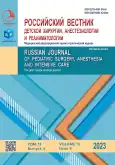Использование продленной вено-венозной гемодиафильтрации и гемоперфузии с полимиксином при фульминантной менингококковой инфекции: клинический случай
- Авторы: Середняков К.В.1,2, Александрович Ю.С.2, Пшениснов К.В.2, Конев А.И.1,2, Иоффе М.Я.1
-
Учреждения:
- Детский научно-клинический центр инфекционных болезней Медико-биологического агентства
- Санкт-Петербургский государственный педиатрический медицинский университет
- Выпуск: Том 13, № 4 (2023)
- Страницы: 591-598
- Раздел: Клинические случаи
- URL: https://journals.rcsi.science/2219-4061/article/view/249868
- DOI: https://doi.org/10.17816/psaic1567
- ID: 249868
Цитировать
Полный текст
Аннотация
Генерализованная фульминантная менингококковая инфекция — одно из наиболее грозных жизнеугрожающих состояний детского возраста, сопровождающихся высокой вероятностью развития осложнений и неблагоприятных исходов, вплоть до инвалидизации, необратимого поражения центральной нервной системы и гибели пациента. Ключевым звеном патогенеза данного состояния является массивный выброс эндотоксина возбудителя и тотальное повреждение эндотелия всех сосудов, что лежит в основе развития септического шока и всех осложнений. Одним из наиболее эффективных методов лечения генерализованной фульминантной менингококковой инфекции считается применение методов экстракорпоральной гемокоррекции, однако, несмотря на несомненный терапевтический эффект, до настоящего времени они не входят в рекомендации высокого уровня доказательности и достаточно редко используются в рутинной клинической практике, причем в большинстве случаев лишь в терминальную фазу заболевания. В статье продемонстрированы особенности течения генерализованной менингококковой инфекции у ребенка 7 лет, отражены все мероприятия интенсивной терапии. Особое внимание уделено оценке тяжести состояния и эффективности методов экстракорпоральной гемокоррекции. Оценка состояния ребенка при поступлении в отделение реанимации и интенсивной терапии по шкале pSOFA составила 11 баллов, что свидетельствовало о наличии декомпенсированной полиорганной дисфункции и стало основанием для проведения продленной вено-венозной гемодиафильтрации. На основании результатов теста активности эндотоксина, Endotoxin Activity Assay (0,67 у. е.) принято решение о проведении гемоперфузии с полимиксином. На фоне проводимой терапии достигнута стабилизация состояния пациента. Через 68 ч после поступления прекращена медикаментозная поддержка гемодинамики, снижены параметры инвазивной искусственной вентиляции легких. На седьмые сутки лечения пациент экстубирован, в динамике явления респираторного дистресса не нарастали. На восьмые сутки после поступления на фоне полной компенсации всех витальных функций в связи с ишемическим повреждением и глубокими некрозами тканей нижних конечностей пациент переведен в многопрофильный хирургический стационар для дальнейшего лечения. Раннее обоснованное применение методов экстракорпоральной гемокоррекции способствует быстрому регрессированию явлений септического шока и выздоровлению пациента, что свидетельствует о высокой эффективности используемых методик и необходимости дальнейших мультицентровых рандомизированных исследований с целью рутинного использования данных методов лечения в клинической практике.
Полный текст
Открыть статью на сайте журналаОб авторах
Константин Владимирович Середняков
Детский научно-клинический центр инфекционных болезней Медико-биологического агентства; Санкт-Петербургский государственный педиатрический медицинский университет
Email: spbny@yahoo.com
ORCID iD: 0000-0002-2213-0477
SPIN-код: 1726-6155
канд. мед. наук
Россия, Санкт-Петербург; Санкт-ПетербургЮрий Станиславович Александрович
Санкт-Петербургский государственный педиатрический медицинский университет
Email: Jalex1963@mail.ru
ORCID iD: 0000-0002-2131-4813
SPIN-код: 2225-1630
д-р мед. наук, профессор
Россия, Санкт-ПетербургКонстантин Викторович Пшениснов
Санкт-Петербургский государственный педиатрический медицинский университет
Автор, ответственный за переписку.
Email: Psh_K@mail.ru
ORCID iD: 0000-0003-1113-5296
SPIN-код: 8423-4294
д-р мед. наук, доцент
Россия, Санкт-ПетербургАлександр Иванович Конев
Детский научно-клинический центр инфекционных болезней Медико-биологического агентства; Санкт-Петербургский государственный педиатрический медицинский университет
Email: icdrkonev@yandex.ru
ORCID iD: 0000-0002-0427-7344
SPIN-код: 7458-6203
канд. мед. наук
Россия, Санкт-Петербург; Санкт-ПетербургМихаил Яковлевич Иоффе
Детский научно-клинический центр инфекционных болезней Медико-биологического агентства
Email: 1964ioffe@mail.ru
ORCID iD: 0000-0002-3366-4896
SPIN-код: 2744-2818
канд. мед. наук
Россия, Санкт-ПетербургСписок литературы
- Aleksandrovich YuS, Pshenisnov KV, Gordeev VI. Intensivnaya terapiya kriticheskikh sostoyanii u detei. Titova LA, editor. Saint Petersburg: N-L, 2014. 976 p. (In Russ.)
- Yushchuk ND. Infektsionnye bolezni. Natsional’noe rukovodstvo. Kratkoe izdanie. Yushchuk ND, Vengerov YuYa, editors. Moscow: GEOTAR-Media, 2022. 848 p. (In Russ.)
- Brady RC. Meningococcal infections in children and adolescents: update and prevention. Adv Pediatr. 2020;67:29–46. doi: 10.1016/j.yapd.2020.03.007
- Medeiros I, Reis Melo A, Baptista V, et al. Meningococcemia: rare but life-threatening. BMJ Case Rep. 2018;2018:bcr2018226914. doi: 10.1136/bcr-2018-226914
- Lekmanov AU, Mironov PI, Aleksandrovich YuS, et al. Sepsis in children: federal clinical guideline (draft). Russian Journal of Pediatric Surgery, Anesthesia and Intensive Care. 2021;11(2):241–292. (In Russ.) doi: 10.17816/psaic969
- rospotrebnadzor.ru [Internet]. Gosudarstvennyi doklad «O sostoyanii sanitarno-ehpidemiologicheskogo blagopoluchiya naseleniya v RF v 2020 g.» MFS po nadzoru v sfere zashchity prav potrebitelei i blagopoluchiya cheloveka [cited: 2023 Oct 24]. Available at: https://www.rospotrebnadzor.ru/documents/details.php?ELEMENT_ID=14933 (In Russ.)
- Angus DC, Barnato AE, Bell D, et al. A systemic revive and meta-analysis of early goal-directed therapy for septic shock: the ARISE, ProCESS and ProMISe Investigators. Intensive Care Med. 2015;41(9):1549–1560. doi: 10.1007/s00134-015-3822-1
- Boeddha NP, Bycroft T, Nadel S, Hazelzet JA. The inflammatory and hemostatic response in sepsis and meningococcemia. Crit Care Clin. 2020;36(2):391–399. doi: 10.1016/j.ccc.2019.12.005
- Brandtzaeg P, van Deuren M. Classification and pathogenesis of meningococcal infections. In: Christodoulides M, editor. Neisseria meningitidis. Methods in Molecular Biology. Vol 799. Humana, Totowa, NJ, 2012. P. 21–35. doi: 10.1007/978-1-61779-346-2_2
- Zughaier SM. Neisseria meningitidis capsular polysaccharides induce inflammatory responses via TLR2 and TLR4-MD-2. J Leukoc Biol. 2011;89(3):469–480. doi: 10.1189/jlb.0610369
- Darton T, Guiver M, Naylor S, et al. Severity of meningococcal disease associated with genomic bacterial load. Clin Infect Dis. 2009;48(5):587–594. doi: 10.1086/596707
- Weiss SL, Peters MJ, Alhazzani W, et al. Surviving sepsis campaign international guidelines for the management of septic shock and sepsis-associated organ dysfunction in children. Intensive Care Med. 2020;46(S1):10–67. doi: 10.1007/s00134-019-05878-6
- Nishizaki N, Nakagawa M, Hara S, et al. Effect of PMX-DHP for sepsis due to ESBL-producing E. coli in an extremely low-birthweight infant. Pediatr Int. 2016;58(5):411–414. doi: 10.1111/ped.12825
- Yaroustovsky M, Abramyan M, Rogalskaya E, Komardina E. Selective polymyxin hemoperfusion in complex therapy of sepsis in children after cardiac surgery. Blood Purif. 2021;50(2):222–229. doi: 10.1159/000510126
- Aleksandrovich YuS, Serednyakov KV, Pshenisnov KV. Extracorporeal hemocorrection in complex therapy of septic shock in children. Russian Journal of Anesthesiology and Reanimatology. 2021;(4):110-117. (In Russ.) doi: 10.17116/anaesthesiology2021041110
Дополнительные файлы






